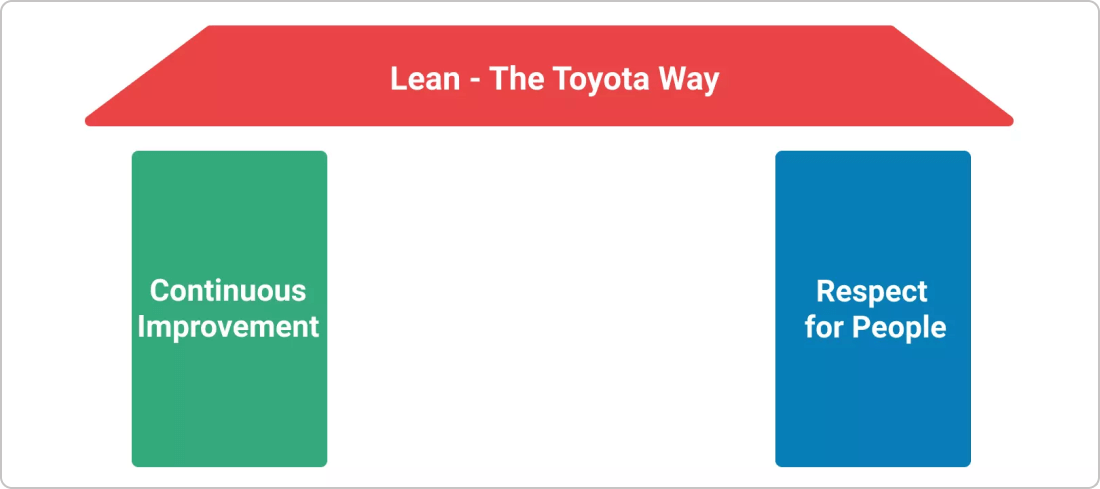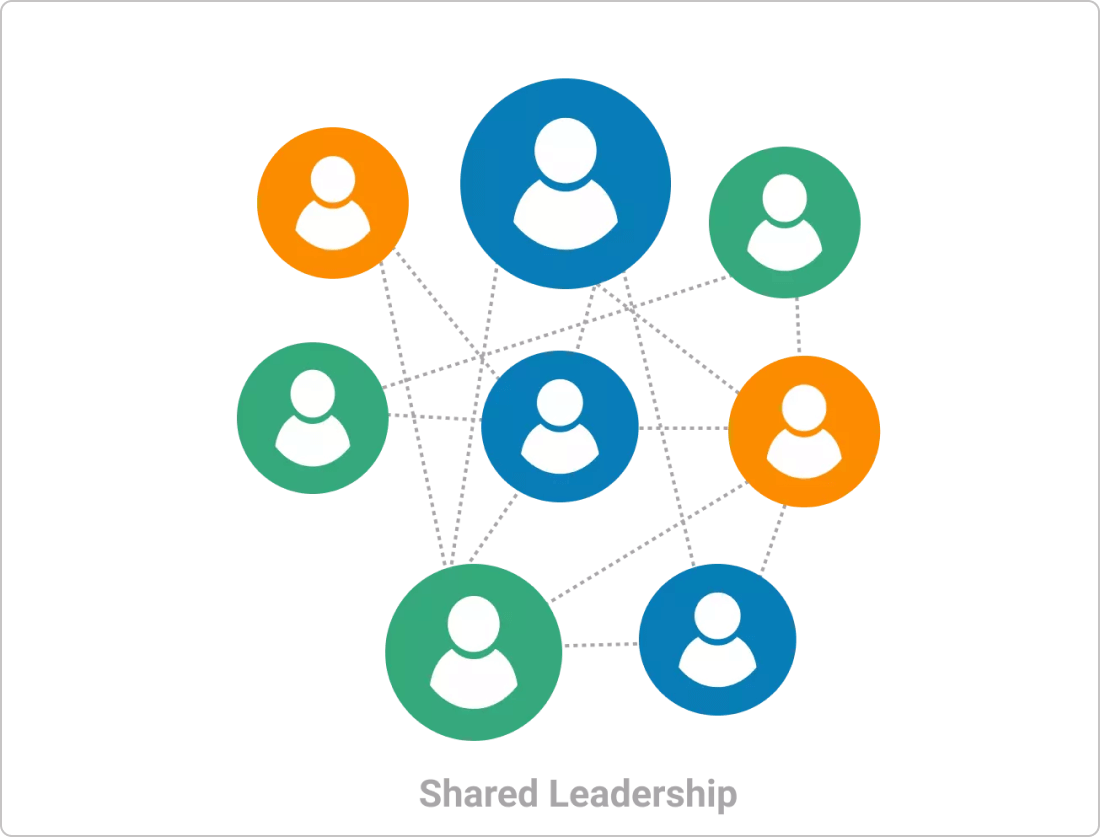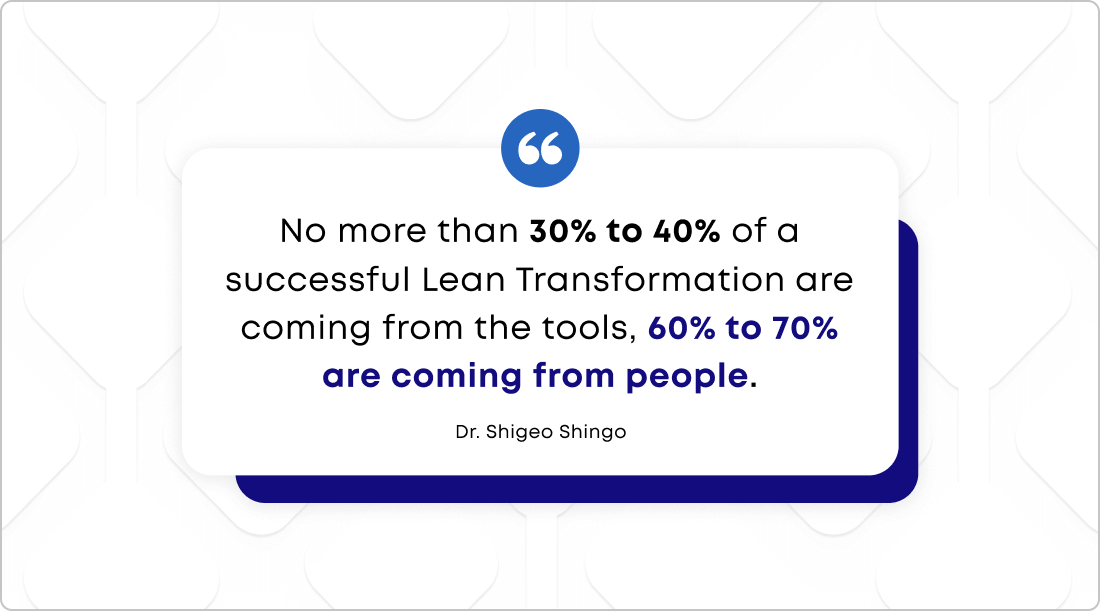What is the optimal path to be more productive and increase profits? This is one of the toughest questions business leaders have always been facing. At present, market competitiveness makes it even more challenging to achieve such goals. What is the right answer? Ingenuity, state-of-the-art service, new management ways, or a shift in the company culture? Today, we’ll attempt to answer this question.
We’ll start with a century-old story that occurred in Japan – the birthplace of the Toyota Production System (TPS) and Lean thinking.
What Is Lean Thinking?
Lean thinking is a shift towards a mindset of managing work in a Lean manner – delivering high customer value and continuous process improvement. This concept refers to producing goods or services with fewer resources and minimum waste through ongoing experimentation. Lean promotes a culture of continuous learning and fast response to increasing demands allowing companies to be more adaptive to the ever-changing business environment.
Derived from the principles of TPS, the Lean concept was formed, which led to the establishment of Lean management in the late 1980s. Eventually, it enabled the spread of Lean philosophy and thinking throughout the world.
The focus of the “Toyota Way” was on the people who do the work. The aim is to facilitate their work, eliminate all waste, interruptions, and overburden, create more free time for workers, and create safer conditions. This allows them to realize their full potential and bring true value.
"Manufacturing must be both efficient and also have respect for the person running the machine."
Taiichi Ohno, Toyota Production System, Beyond Large-Scale Production
What Are the 3 True Goals of TPS?
1. Make Work Easier
Young Sakichi Toyoda (founder of Toyota) came up with his first invention – an automated loom that enabled its operation using only one hand. The invention’s goal spurred out of a simple need - to make people’s work easier. Still, it had a tremendous positive impact on quality improvement, process efficiency, and productivity.
2. Мake Work Safer
Sakichi’s invention also resolved a significant problem in the old process of weaving, which created a lot of dust and caused lung damage. The newly added feature created a safer workplace for the operators. This improvement in the invention originated from simple care about the line workers’ health, but it naturally led to an increase in line productivity.
3. Make Work Meaningful
Another innovation introduced by Sakichi was a simple device to detect broken threads. In such an event, the automatic loom would immediately shut down as a signal of a problem. The goal of the device was to avoid production defects by enabling workers to operate more than one machine to fix the issue. The ability to run more than one machine at a time made operators’ work more meaningful, resulting in increased production capacity.
The concept is known as Jidoka or automation with a human touch.
What Is the Real Focus of Lean Thinking?
The real focus of Lean thinking lies in delivering maximum value to customers while minimizing waste. At its core, it aims to provide customers with what they want within budget, on time, and with the fewest possible resources.
Another goal of this mindset is to create an organization where communication opens up between all parties. It supports the idea of everyone being actively involved in identifying problems and opportunities and proposing ideas for continuously improving internal processes.
Lean thinking fosters a Lean culture within an organization of improved efficiency, enhanced quality, and increased productivity.
Lean Pillars: Building the Foundation for Change
Fostering a Lean culture calls for realizing the basics of Lean. Cultural transformation begins by understanding the two pillars of Lean and how to use them to achieve effective organizational change.
Let’s first take a closer look at the two building blocks of Lean.
1. Continuous improvement mindset
Encourage small but incremental changes in processes, promote cross-functional knowledge sharing, gather regular feedback to make adjustments when needed, and always search for better ways to enhance the current state.
2. Respect for people
A truly successful work process does not have one secret answer and does not rely on applying specific practice. It’s a process in motion that evolves with the ideas of the people who shape it. Respecting people’s ideas, actively listening to their problems, and acknowledging their input, skills, and feelings are crucial for creating a productive work environment.
 Lean Thinking Pillars
Lean Thinking Pillars
What Are the Five Principles of Lean Thinking?
The five principles of lean thinking include identifying value, mapping how value is created, creating a flow, establishing a pull system, and always seeking improvement.
- Identify value: Value in Lean is considered everything your customer is willing to pay you for. Thus, you need to identify the value from your customer’s perspective and work on activities that are aligned with this value and do not generate additional costs and waste.
- Map the value stream: This step requires mapping all actions and people involved in producing and delivering value. In this way, you can spot areas of waste and inefficiency that need improvement. Usually, work management board like kanban boards are widely used to map every step of the process.
- Create a flow: Creating a smooth flow of value delivery requires identifying wasteful activities and removing them from the flow. This includes spotting process bottlenecks, reducing waiting time, increasing capacity, etc. A good practice to achieve maximum efficiency is applying work-in-progress (WIP) limits.
- Establishing a pull system: This Lean principle advocates the idea that work is pulled only when there is a genuine customer need for it and the team has the capacity to do it. This practice prevents you from overproduction and losing resources.
- Continuous improvement: By enhancing activities that generate the most value for your customers while removing waste, you will continually improve every process within your team. There are different methods and techniques (such as PDCA, stand-up meetings and more) to encourage continuous improvement, and one of the most crucial ones is to ensure that employees on every level are engaged in finding better ways of working.
What Is an Example of Lean Thinking?
An excellent example of lean thinking is the principle of Just-in-time (JIT) production introduced by Toyota and becoming one of the two main pillars of the TPS. The idea behind JIT is that you only produce if there is a demand for your product or service. This prevents you from storing extra resources or finished goods, thus eliminating waste and optimizing the usability of resources.
How to Foster a Lean Culture with Lean Thinking?
Lean is about changing the culture. This enormous objective begins with understanding the need for change, adequate leadership, and, more importantly, a shift in people’s perspective of how work is handled and how teams work together.
Building a Lean culture calls for organizations to place their mindset on the foundation of lean thinking. Instilling this mindset, driven by customer focus and a willingness to challenge the status quo in pursuit of continuous improvement, allows leaders to make smarter decisions and execute actions that are in the ultimate favor of their organizations.
Fostering Lean culture does not end with shifting people’s attitudes by integrating Lean values only. A necessary step supporting any Lean transformation is incorporating Lean practices into the organizational culture.
Let's review some examples of practices that contribute to the successful implementation of Lean.
- Implement the shared leadership model where everyone’s individual contribution is valued and sharing ideas and opinions is encouraged. This creates an environment for shared responsibility and empowers employees to deliver greater customer value.
- Implement a pull system to prevent people from being overburdened and be responsible for their work. This Lean technique allows workers to start work only when there is a request for it. They can pull their work items when they have the capacity to do so. As a result, a pull system creates a sense of self-ownership and trust and reduces stress while improving the process flow.
- Implement regular feedback loops/ cadences to keep everyone in the loop. This network of meetings aims to review current processes and ongoing experimentations and extract valuable insights at an early stage. This practice allows teams to be more proactive, collaborative and constantly identify areas for improvement.
- Visualize the flow of work for better management and predictability. Mapping out the whole process flow helps to spot areas of waste and bottlenecks. Thus, teams have better control over their processes and can take necessary actions to optimize the value stream by resolving defects, minimizing rework, and ensuring a smooth workflow.
Inspire Lean Thinking with Lean Leadership
Lean leadership is about mentoring, embodying, and inspiring Lean thinking and Lean values throughout your organization. Leadership behavior is important for shaping strategic decisions and establishing company goals, but most importantly, it greatly impacts the culture of one organization.
As mentioned, Lean teaches us to continuously improve our work, our processes, and ourselves. Taking this to heart in the business world makes judgmental behavior counterproductive to creating real value. Instead, a lean leader embraces critical thinking and offers discussion. Lean tools such as Kanban help by bringing the focus on the work itself rather than the people who do the work. In addition, the 5 Whys root cause analysis tool, for instance, enables people to improve the way work is performed continuously.
Lean leadership has to offer guidance, constructive feedback and should instill a need for improvement. It's amazing to see this in action! In Businessmap, I'm privileged to work in an environment where this principle is taken to heart.
 Lean thinkers seek to re-engage employees by valuing their expertise and eliciting their solutions, rather than imposing them. Lean leaders move away from:
Lean thinkers seek to re-engage employees by valuing their expertise and eliciting their solutions, rather than imposing them. Lean leaders move away from:
- Providing answers;
- Searching for immediate solutions;
- Setting goals for subordinates;
... and move toward:
- Asking the right questions;
- Searching for root causes;
- Uniting individual and business goals.
The process of leading an organization into Lean thinking needs to be done carefully, with complete commitment and buy-in from the top-level leadership.
What Does It Take to Adopt Lean Philosophy?
Lean thinking starts at the top, but also from the inside out. Embracing lean philosophy is a continuous journey that requires full dedication and willingness to understand and apply the Lean principles and techniques.
Lean processes represent powerful ways to improve productivity, quality, and profits. They must be fully adopted, committed to, and practiced daily.
Lean thinkers are indeed driven by a strive always to improve while respecting people around them and instilling trust. Adopting this philosophy within yourself is the first step towards implementing Lean and building your Lean empire!
Remember Lean transformation should not be considered as a project. It is a strategy!
A long-term strategy for a company that should be well communicated with all employees.
A strategy that embraces the Lean principle for enhanced productivity and eliminating waste.
A strategy that inspires and creates a lasting change.
If you begin this journey with the presumption that adopting Lean is a project with a start and end date, all efforts and time may lead to failure soon after.
As a final word, we want to quote one of the greatest leading experts on manufacturing practices and the Toyota Production System – Dr. Shigeo Shingo.


Iva Krasteva
Content Strategist | Agile Practitioner | Kanban Certified
Iva is a Kanban-certified Agile expert with hands-on experience in SEO, content creation, and Lean practices. She has published dozens of articles on Lean, Agile, and Kanban practical applications. Iva actively promotes collaborative, flexible work environments and regularly shares process optimization insights through writing.



